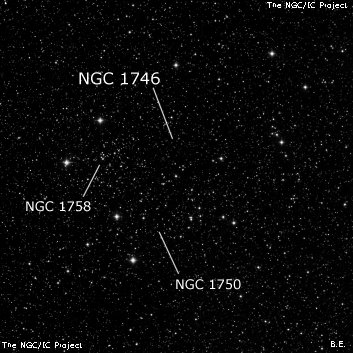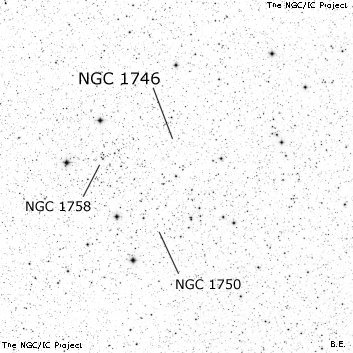NGC/IC Project Restoration Effort
(This is a very very beta version)
NGC1746


Basic Information
Location and Magnitude
Right Ascension: 5:3:50.0
Declination: +23:46:12
Constellation: TAU
Visual Magnitude: 6.1
Historic Information
Discoverer: d'Arrest
Year of discovery: 1863
Discovery aperture: 11.0
Observational
Summary description: Cl, P
Sub-type: *Grp
Corwin's Notes
=====
NGC 1746. This is a curious case, found by d'A while searching for NGC 1750
(which see) = H VIII 43. He describes it as a poor cluster, and places it
about 10 arcmin north of WH's place -- but nevertheless calls it H VIII 43.
Dreyer apparently thought it a separate object since he gave it a new GC
number in the GC supplement.
There is a group of about a dozen faint stars at d'A's place, and a much more
extensive group at WH's place (see the note for N1750 for a description).
While I'm doubtful that d'A's object is worth numbering, I'm going to follow
Dreyer as closely as possible and retain both objects at something like their
original positions.
I must note, however, that Galadi-Enriquez et al (A&AS 131, 239, 1998) have
shown that this group of stars is neither astrometrically nor photometrically
a real cluster. It is no more than a random clump in the rich Milky Way field
in Taurus.
Steve's Notes
=====
NGC 1746
17.5" (2/22/87): very bright, very large, large range of magnitudes, spread out overall but locally rich in a few spots. Includes two main subgroups - NGC 1750 and NGC 1758 - which are probably the only clusters here, along with several mag 7.5-8.5 stars. NGC 1750 consists of two dozen stars on the south side. It appears as a fairly large oval oriented NW-SE with a void in the center and includes a nice mag 9.1/9.1 pair at 20". NGC 1758 is a richer, roundish group of stars close northeast (though probably unrelated physically to NGC 1950) including about two dozen stars. NGC 1758 is bracketed by two mag 8 stars oriented N-S and a mag 7 star is off the east end. Includes five mag 13 stars at the east side.
NGC 1746, although often applied to the 40' field including NGC 1750 and 1758, may in fact be a duplicate of NGC 1750 or just a group of faint field stars noted by d'Arrest while searching for NGC 1750.
13" (12/22/84): about 100 stars in 20' field. The brightest mag 7 star (HD 32461) at the south edge and there are many nearby bright stars.



